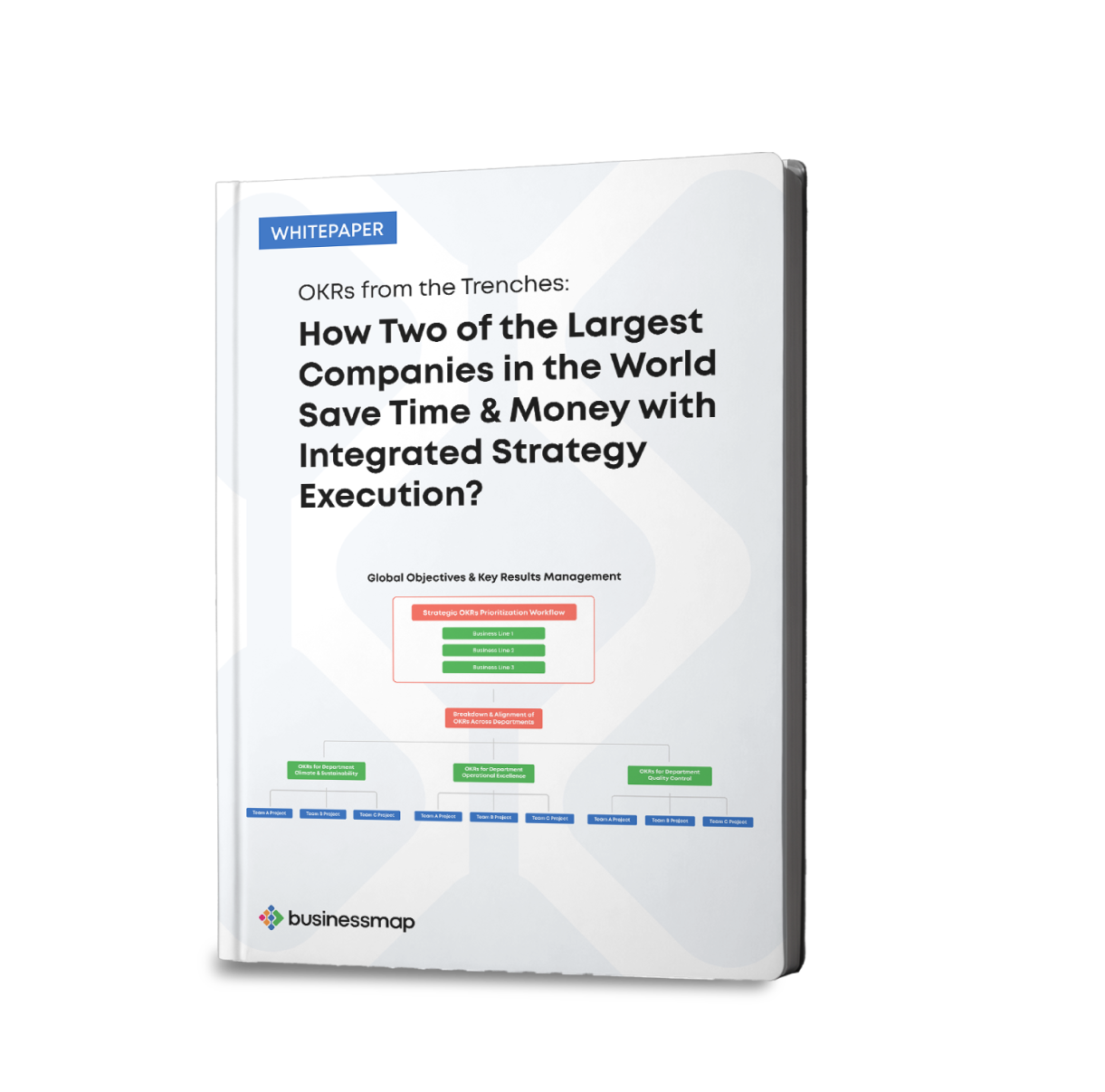Objective and Key Results (OKRs) and Management by Objectives (MBOs) are two goal-setting systems popular among organizations with a high-performance culture.
OKRs evolved from MBOs. Another similarity between OKRs and MBOs frameworks is that the process requires an organization to set specific outcomes it wants to achieve.
There are a set of differences between MBOs and OKRs. MBO goal-setting is limited to “what,” while OKRs expand further on this question by adding a number of measures to evaluate success. Other key differences include a degree of autonomy, structure, the review process, and how often and quickly goals are admissible to changes.
We have already covered what are OKRs, so in this article, we will explain what is MBO, the differences and similarities between OKRs and MBOs, OKR versus MBO benefits, and which of the two frameworks is better for strategic goal setting.
What Is MBO?
Management by objectives (MBO), also known as management by planning (MBP), is a management framework that emphasizes the importance of setting measurable objectives. The framework was created by Peter Drucker in 1954 and has been adopted by many organizations as a way to measure success and set goals.
In MBO, the leaders are the ones who specify the organization’s objectives for a cycle, where a cycle usually has a duration of 12 months (which isn’t very Agile). Within that cycle, leaders set the objective for each team. The only autonomy the employees have is to choose their tasks so they can meet the goals set for them.
As part of an MBO goal cycle, achieving the objective is expected, so performance reviews, increased compensation, and bonuses are frequently connected to the achievement.
What Is an Example of an MBO?
Let’s take a look at the following MBO goal examples.
- Become the market leader.
- Expand sales abroad by 10%.
- Raise brand profile by 25%.
MBOs, unlike OKRs, do not always explain why they are important and describe no additional details about how progress is measured. In OKRs, objectives are linked with Key Results that explicitly define when the Objective is achieved.
If we use the MBOs examples above, the OKRs examples will be:
- Gain the largest market share in Europe to become the market leader in Europe.
- Create new offices in ten countries to expand sales abroad by 15%.
- Participate in every major event in our industry to raise brand profile by 30%.
What Is an OKR?
OKR (alternatively OKRs) is an acronym for Objectives and Key Results. OKR is a goal-setting framework used by organizations, teams, and individuals to define measurable goals and track their results. OKRs consist of an objective (a goal) and key results, which measure progress towards achieving the defined goal. Objectives should be inspiring for the organizations, teams, and individuals that work towards them.
Additionally, objectives can be supported by initiatives, which are plans and activities to achieve the key results. The clear measurement of key results is essential, and it is done either on a scale or with numerical values. The precise values assist decision-makers in determining whether those involved in working toward the key result have succeeded or not.
OKR vs. MBO Example
Let’s take a look at this OKR vs. MBO example and compare how a goal-setting process will look like for a Marketing department using each framework.
| Department |
OKR Goal Setting Example |
MBO Goal Setting Example |
| Marketing |
Objective: Become the leading content platform for healthcare professionals seeking the most up-to-date research papers in healthcare.
Key Results:
1) Increase the number of published healthcare research papers per month from 10 to 20 articles.
2) Increase the number of our platform being featured on industry-specific digital media per month from 15 to 20 features.
3) Increase our platform’s uptime each month from 94% to 99%.
|
Be the leading content platform for people working in healthcare. |
How Two of The Largest Organizations in the World Save Time & Money with OKRs?
What Are the Differences between MBO vs. OKR?
We can distinguish seven major differences between MBO vs. OKR.
1. MBOs set out what you want to achieve, while OKRs set out the what and how to achieve it.
Defining what you're trying to accomplish is at the heart of the MBO approach. The way an employee or team achieves a goal, and the measurement of their performance towards achieving that goal, are mainly open and flexible. In contrast, OKR drills down much more deeply. OKRs have two components: The Objectives and a set of key results to achieve them. Key results identify what success looks like and what needs to be done in order to reach the goal, resulting in quantitative measures of success.
2. MBOs are reviewed annually, while OKRs are usually monthly or quarterly.
While most OKRs have monthly or quarterly cycles, MBOs are reviewed annually. The result is that MBOs are not tracked frequently. In an MBO cycle, it is harder to make changes. Since the pace of monthly or quarterly reviews is faster in OKRs, there are much more opportunities to adapt and unlock agility through OKRs.
3. MBOs goals are more private, while OKRs goals are completely transparent.
An employee and their line manager set MBO objectives in a private discussion, and the objectives are confidential. Compensation is one reason for this confidentiality.
OKRs, on the other hand, are much more transparent and are often created through team discussions, so the entire team decides how to support the company's overall objectives. OKRs can be viewed by anyone, from the CEO to the front desk manager.
4. MBOs are naturally risk-averse, while OKRs are aggressive and aspirational.
People are expected to achieve their objectives fully if their compensation is linked to their objectives, as is the case in MBOs. This means that employees’ objectives are often set in the safe zone. A key advantage of OKRs is the "dare to fail" mentality, which promotes innovation and stretching beyond existing capabilities since compensation is not tied to them.
5. MBOs set goals top-down, while in OKRs goals are set top-down and bottom-up.
MBO places the responsibility of setting company goals on the executive level. Based on these high-level goals, departments, teams, and employees are then given their own goals. Goal setting is, therefore, a top-down process in MBO.
When utilizing OKRs, executives set goals for the company as a whole, and then departments, teams, and employees align their goals with them. In addition, employees at each level set their own objectives, which are aligned with the goals of their teams, departments, and organization. Consequently, the process of setting goals involves both a top-down and bottom-up approach.
6. MBOs are mainly quantitative, while OKRs balance qualitative with quantitative success.
A MBO does not specify success parameters, only the final result. There can be unintended consequences when an MBO is purely quantitative. Unlike MBOs, OKRs recognize that success is rarely a number but a combination of qualitative and quantitative success.
7. MBOs are tied to compensation, while OKRs aren’t.
MBOs are usually set in relation to bonuses and salaries. OKRs separate rewards from objectives to foster innovation. In MBOs, individuals’ annual performance determines their compensation. OKRs, in contrast, emphasize the importance of shared goals.
What Are the Advantages of OKRs over MBOs?
Using OKRs over MBOs can be beneficial for your organization in the following situations.
- When an organization needs to concentrate its efforts. The OKR process starts by asking what is the most important thing for your organization for the next one or three months (depending on your goal-setting cadence). The OKRs provide leaders with a compass as well as a baseline for assessing their teams' progress.
- When an organization wants its day-to-day activities to align with its company vision. OKRs break down long-term goals into short-term wins.
- When an organization aims to encourage innovation and creative thinking. OKRs inspire employees to aim higher than they think is possible.
Businessmap is the most flexible software
to align work with company goals
Related Articles








